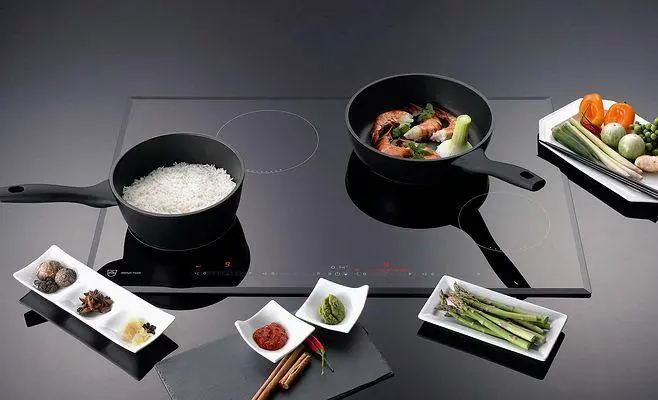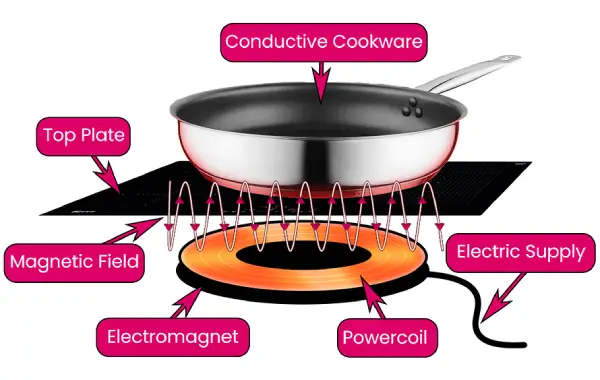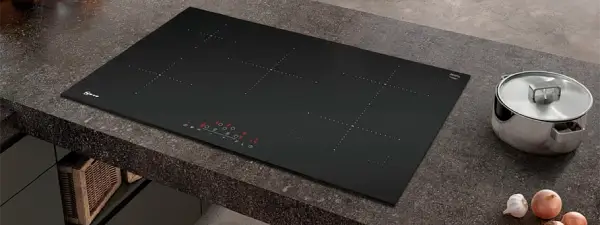To expand your news reach, consider advertising with our media partner, Patch Media, at https://heypapipromotionsmedia.town.news/. Patch is a nationwide news network comprising over 1,000 hyperlocal websites dedicated to community news across the United States. For press release distribution services, please call or visit https://heypapipromotions.com/advertise.
Despite their long history in the culinary scene, induction hobs have recently gained popularity in the home kitchen. What is an induction hob and should you consider getting one?
The purpose of this article is to explain what an induction hob is, whether they're any good, and answer your most frequent questions.
The purpose of this article is to explain what an induction hob is, whether they're any good, and answer your most frequent questions.

What Is anInduction Hob?
An induction hob, also known as an induction cooktop, is a type of cooking appliance that uses electromagnetic induction to heat cookware directly. Unlike traditional stovetops that use gas or electric heating elements to transfer heat to the cookware, an induction hob heats the cookware by creating an electromagnetic field between the hob and the cookware.
As an induction hob heats the pot or pan directly, less energy is wasted. In addition, it uses less power, is usually faster, and is safer than other types of electric hobs.
As an induction hob heats the pot or pan directly, less energy is wasted. In addition, it uses less power, is usually faster, and is safer than other types of electric hobs.
How Do Induction Hobs Work?

Induction hobs operate through the fascinating principles of electromagnetic induction to heat cookware directly. Beneath the sleek ceramic surface of the hob, copper coils generate a rapidly alternating magnetic field when an electric current is passed through them. Placing ferrous (magnetic) cookware on the hob leads to an interaction between the magnetic field and the metal, inducing an electric current within the cookware itself. This induced current encounters resistance within the metal, producing heat directly in the cookware. Consequently, the cookware becomes the source of heat, efficiently transferring it to the food or liquid inside. The precise and instant control of the magnetic field allows for rapid adjustments in temperature, offering users responsive cooking capabilities.
Induction hobs are celebrated for their safety features and energy efficiency. Unlike traditional cooktops, the ceramic surface of induction hobs remains relatively cool, minimizing the risk of burns and making them safer to touch. Additionally, many induction hobs are equipped with automatic shut-off functions, enhancing safety by turning off the heat when no compatible cookware is detected. Furthermore, the energy efficiency of induction cooking stems from the direct heat generation in the cookware, resulting in minimal heat loss to the surrounding environment. With their rapid heating, precise temperature control, and safety features, induction hobs have become a popular choice in both residential and professional kitchens, revolutionizing the cooking experience.
Induction hobs are celebrated for their safety features and energy efficiency. Unlike traditional cooktops, the ceramic surface of induction hobs remains relatively cool, minimizing the risk of burns and making them safer to touch. Additionally, many induction hobs are equipped with automatic shut-off functions, enhancing safety by turning off the heat when no compatible cookware is detected. Furthermore, the energy efficiency of induction cooking stems from the direct heat generation in the cookware, resulting in minimal heat loss to the surrounding environment. With their rapid heating, precise temperature control, and safety features, induction hobs have become a popular choice in both residential and professional kitchens, revolutionizing the cooking experience.
What Are the Pros and Cons of Induction Hobs?
Cost
As technology advances and competition increases, induction hobs are becoming increasingly affordable. Initially, they cost more than gas, electric, or halogen hobs. The cost of an induction hob today is much cheaper than it was ten years ago. You will also need an electrician to install the hob. However, induction hobs have the advantage of being more energy efficient than gas hobs. Over the long run, this can offset the initial cost of buying the hob.
Efficiency
Since induction hobs heat the food at a low voltage, they are energy-efficient. Furthermore, since they only heat the pan, there is no waste of energy on the hob. As opposed than electric hobs, which can be slow to heat up, induction hobs heat the pan quickly. They also provide instant cooking control, which is a way to save energy. Induction hobs can also be argued to heat up boiling water faster than kettles, so if you want a hob that heats up quickly and cools down quickly, an induction hob might be the best choice.
Speed
Induction hobs allow you to heat things up very quickly. In fact, induction cooking is faster than any other cooktop option. Because the pan is directly heated, there is no time wasted waiting for heat to transfer. Induction hobs respond almost immediately to changes in heat settings, so you have more precise control over the cooking temperature.
Cleaning
Because induction hobs are made up of a flat surface, they are easy to clean. Since the heat is controlled, you are less likely to have to wipe up spills on the hob because the pans don't often boil over. Additionally, since the hob stays relatively cool, spills won't stick to it.
Safety
Induction hobs are safer than traditional forms of hobs, such as gas and electric, because the hob itself doesn't heat. The hob itself is not heated, so it reduces the risk of accidental burns. Families with small children may prefer this type of hob since they place a high priority on safety in the kitchen.
As an added benefit, induction hobs do not have a naked flame, which makes them safer as far as fire risk is concerned. They also shut off when the pan boils dry or when no cookware is on the surface, which is an extremely useful safety feature.
Equipment
A drawback of opting for an induction hob is its limitation on the use of regular pots and pans unless they feature the appropriate base. Induction hobs exclusively function with iron-based cookware that facilitates the transmission of magnetic energy into the metal, enabling it to heat up. Consequently, this might entail the need to invest in a new set of pots and pans, although suitable options are available at reasonable prices.
For those unwilling to part with their cherished cookware, an alternative solution exists in the form of an induction disc. This accessory can be purchased and affixed to conventional pans, allowing them to be seamlessly used with the new induction hob. This way, you can maintain the familiarity of your favorite cookware while benefiting from the advantages of induction cooking technology.
Noise
A negative aspect of an induction hob is that they are noisier than other types of hobs. However, this should only be a low humming and/or some clicking. The noise should hopefully be drowned out by the sounds of your food cooking.
As technology advances and competition increases, induction hobs are becoming increasingly affordable. Initially, they cost more than gas, electric, or halogen hobs. The cost of an induction hob today is much cheaper than it was ten years ago. You will also need an electrician to install the hob. However, induction hobs have the advantage of being more energy efficient than gas hobs. Over the long run, this can offset the initial cost of buying the hob.
Efficiency
Since induction hobs heat the food at a low voltage, they are energy-efficient. Furthermore, since they only heat the pan, there is no waste of energy on the hob. As opposed than electric hobs, which can be slow to heat up, induction hobs heat the pan quickly. They also provide instant cooking control, which is a way to save energy. Induction hobs can also be argued to heat up boiling water faster than kettles, so if you want a hob that heats up quickly and cools down quickly, an induction hob might be the best choice.
Speed
Induction hobs allow you to heat things up very quickly. In fact, induction cooking is faster than any other cooktop option. Because the pan is directly heated, there is no time wasted waiting for heat to transfer. Induction hobs respond almost immediately to changes in heat settings, so you have more precise control over the cooking temperature.
Cleaning
Because induction hobs are made up of a flat surface, they are easy to clean. Since the heat is controlled, you are less likely to have to wipe up spills on the hob because the pans don't often boil over. Additionally, since the hob stays relatively cool, spills won't stick to it.
Safety
Induction hobs are safer than traditional forms of hobs, such as gas and electric, because the hob itself doesn't heat. The hob itself is not heated, so it reduces the risk of accidental burns. Families with small children may prefer this type of hob since they place a high priority on safety in the kitchen.
As an added benefit, induction hobs do not have a naked flame, which makes them safer as far as fire risk is concerned. They also shut off when the pan boils dry or when no cookware is on the surface, which is an extremely useful safety feature.
Equipment
A drawback of opting for an induction hob is its limitation on the use of regular pots and pans unless they feature the appropriate base. Induction hobs exclusively function with iron-based cookware that facilitates the transmission of magnetic energy into the metal, enabling it to heat up. Consequently, this might entail the need to invest in a new set of pots and pans, although suitable options are available at reasonable prices.
For those unwilling to part with their cherished cookware, an alternative solution exists in the form of an induction disc. This accessory can be purchased and affixed to conventional pans, allowing them to be seamlessly used with the new induction hob. This way, you can maintain the familiarity of your favorite cookware while benefiting from the advantages of induction cooking technology.
Noise
A negative aspect of an induction hob is that they are noisier than other types of hobs. However, this should only be a low humming and/or some clicking. The noise should hopefully be drowned out by the sounds of your food cooking.
Which Induction Hobs are Best for You?

If you've reached the decision to replace your aging hob and are contemplating the merits of an induction hob, determining the right model can be a pivotal step. A plethora of leading brands, including HEME, offer a diverse range of induction hobs, providing you with ample choices to align with your preferences.
Before delving into specific models, consider your budgetary constraints, as prices can span from £300 to £3,000 for top-tier variants. Assess your cooking needs and family size to gauge the appropriate size and features required. Furthermore, evaluate your kitchen space to ensure seamless installation and contemplate how the induction hob will harmonize with your kitchen's decor. Induction hobs, renowned for their modernity and style, can be a compelling addition, especially if you're undergoing a comprehensive kitchen upgrade.
For a comprehensive overview of available models, a visit to our showroom, where HEME's cutting-edge induction hobs are showcased, is highly recommended. Our knowledgeable sales experts stand ready to provide invaluable assistance and advice tailored to your specific requirements. Additionally, perusing online reviews can offer insights into the performance and suitability of various models.
Keep an eye out for additional features, as certain induction hob brands, including HEME, integrate functionalities like timers, child safety locks, and flexible cooking zones. Some advanced models even incorporate temperature monitoring, adjusting heat levels as needed, and issuing alerts when the hob's contents reach boiling point—a boon for energy-conscious users. With HEME's commitment to innovation and quality, our induction hobs promise not only style and functionality but also energy efficiency, contributing to potential savings on your energy bill.
Before delving into specific models, consider your budgetary constraints, as prices can span from £300 to £3,000 for top-tier variants. Assess your cooking needs and family size to gauge the appropriate size and features required. Furthermore, evaluate your kitchen space to ensure seamless installation and contemplate how the induction hob will harmonize with your kitchen's decor. Induction hobs, renowned for their modernity and style, can be a compelling addition, especially if you're undergoing a comprehensive kitchen upgrade.
For a comprehensive overview of available models, a visit to our showroom, where HEME's cutting-edge induction hobs are showcased, is highly recommended. Our knowledgeable sales experts stand ready to provide invaluable assistance and advice tailored to your specific requirements. Additionally, perusing online reviews can offer insights into the performance and suitability of various models.
Keep an eye out for additional features, as certain induction hob brands, including HEME, integrate functionalities like timers, child safety locks, and flexible cooking zones. Some advanced models even incorporate temperature monitoring, adjusting heat levels as needed, and issuing alerts when the hob's contents reach boiling point—a boon for energy-conscious users. With HEME's commitment to innovation and quality, our induction hobs promise not only style and functionality but also energy efficiency, contributing to potential savings on your energy bill.
Originally Posted On: https://www.zsheme.cn/is-it-worth-it-to-buy-an-induction-hob.html
Comments